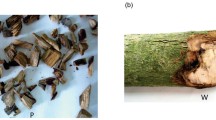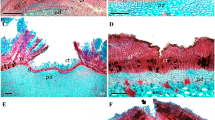Summary
A number of fungi causing heartrot in living trees penetrate into the stem through injured or rotten branches. On the base of normally withering softwood boughs, a zone strongly saturated with resins is formed. Similarly, on the base of dying hardwood branches a zone is found that is characterized by a high starch accumulation and a small, darker separating layer with tyloses and woundgum-like inclusions as a boundary between bough and stem. The resin zone and the seperating layer prevent branchwood-inhabiting fungi by mechanical and chemical means from entering into the stem. Possibly, the protecting effect of these zones is intensified by a certain antagonism between various moulds rotting branchwood or white rot fungi decaying sapwood and some basidiomycetes infecting and destroying the heartwood subsequently.
Since the development of these protecting zones requires living parenchyma cells, they can only be formed in sapwood. Therefore, in older branches, where pithiness still has begun, a protection layer is found in the sapwood region, but missing in the heartwood. When such branches wither or die for any reason, heartwood destroying fungi are able to penetrate through the pith of the dead branch into the pith of the trunkwood, thus causing extensive heartrot.
Similar content being viewed by others
Literatur
Alcubilla, M.; v. Aufsess, H.; Cerny, G.; Rehfuess, K. E., 1974: Untersuchungen über die Pilzhemmwirkung des Fichtenholzes (Picea abies Karst.). In:Kuhlmann, E. G. (Ed.), Procee-dings of the Fourth International Conference on Fomes annosus. Athens, Georgia, Sept. 17–22, 1973, 139–162.
v. Aufsess, H., 1973: Einige Pilzschäden an alten Eichen. Forstw. Cbl.92, 153–169.
Dietrich, G., 1973: Untersuchungen über die Astbildung und natürliche Astreinigung der Heißtanne. Forstwiss. Forsch. Beih. z. Forstw. Cbl. H. 34, Hamburg und Berlin: Paul Parey.
Gelinsky, H., 1933: Die Astreinigung der Rotbuche. Z. Forst- u. Jagdwesen, S. 289.
Hartic, R., 1900: Lehrbuch der Pflanzenkrankheiten. 3. Aufl., Berlin.
Hugendobler, J., 1965: Zur Cytologie der Kernholzbildung. Vierteljahresschr. Naturforsch. Ges. Zürich110, 321–342.
Köster, E., 1934: Die Astreinigung der Fichte. Mitteilung aus Forstwirtsch. und Forstwissensch.5, 379–392.
Liese, J., 1936: Beiträge zum Kiefernbaumschwammproblem. Forstarchiv12, 37–48.
Mayer-Wegelin, H., 1936: Ästung. Hannover.
Möller, A., 1910: Der Kampf gegen den Kiefernbaumschwamm. Z. Forst- u. Jagdwesen17, 129–145.
v. Pechmann, H., 1973: Die Verkernung des Astholzes und die Entstehung von Stammfäulen. Proceedings IUFRO-Division 5, Meeting 22. Sept. 12. Okt. 1973, Republic of South Africa, Vol. 2, 1122–1128.
Ziegler, H., 1968: Biologische Aspekte der Kernholzbildung. Holz, Roh-, Werkstoff26, 61–68.
Author information
Authors and Affiliations
Rights and permissions
About this article
Cite this article
von Aufsess, H. Über die Bildung einer Schutzsperre an der Astbasis von Laub- und Nadelbäumen und ihre Wirksamkeit gegen das Eindringen von Pilzen in das Kernholz lebender Bäume. Forstw Cbl 94, 140–152 (1975). https://doi.org/10.1007/BF02735932
Published:
Issue Date:
DOI: https://doi.org/10.1007/BF02735932




